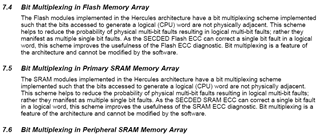Other Parts Discussed in Thread: TMS570LC4357-SEP
Hi,
Since we are dealing safety critical systems, we were asked to provide SEE upset rate for the part TMS570LS3137TMEP.
One recent thread says it is not available for this part.
And there is an old thread that says TI can share based on NDA
Could anyone give some clarity or information on this.
Thanks,
Jaiganesh



 <-- Device Safety Manual
<-- Device Safety Manual